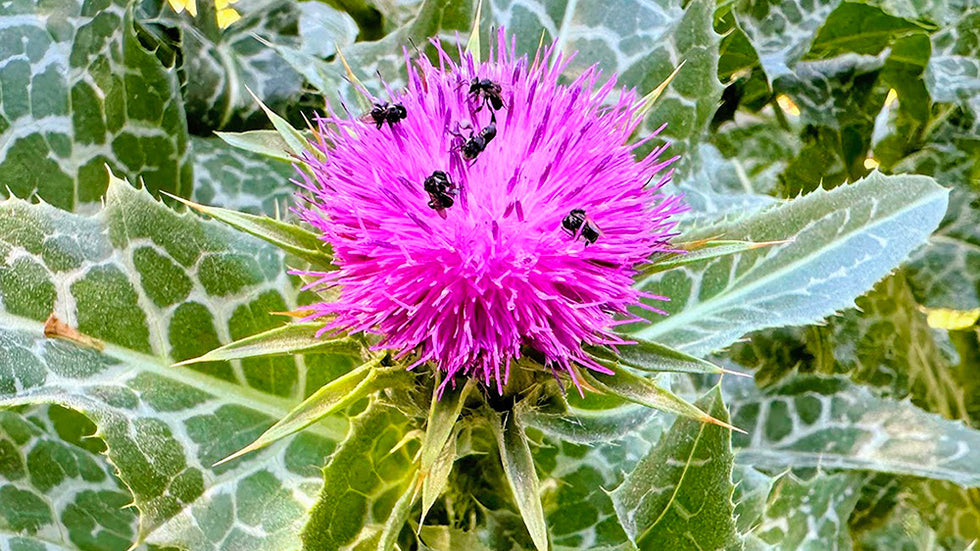Health Benefits of St Mary's Thistle

Introduction
Botanical Name: Silybum marianum
Family: Asteraceae
St Mary's Thistle, also known as Milk Thistle, is an annual herb here in SE Qld. It belongs to the Asteraceae family (the daisy family). It grows up to 1.5 meters tall when it is happy. It has large, prickly, glossy green leaves marked with milky white veins and has ties to Christian legend, suggesting the white spots represent the milk of the Virgin Mary. The plant produces vibrant, purple, thistle-like flowers that can be 4 to 12 cm in diameter. After flowering, the seeds develop, tucked in the spikey flower head. The seeds are the primary source of the plant's medicinal properties, which are renowned for aiding liver health.

|

|
| Dried St Mary's Thistle | Dried St Mary's Thistle Powder |
| From $4.50 | From $6.40 |
| SHOP NOW | SHOP NOW |
Medicinal Use
The primary medicinal component of St Mary's Thistle is silymarin. Studies highlight silymarin's ability to protect liver cells and even improve liver function in those with conditions like cirrhosis. Its antioxidant properties help combat oxidative stress in the liver, which can arise from alcohol, poor diet, or environmental toxins. Apart from that, it's also commonly used to treat jaundice, hepatitis, and gallbladder disorders.
Milk thistle has a strong reputation among herbalists for aiding in detox and recovery, particularly after toxin exposure from alcohol or medications. Many practitioners have seen patients experience improved liver enzyme levels after using silymarin supplements, suggesting an actual boost in liver health. For those considering milk thistle for liver health, it’s always a good idea to check in with a healthcare professional, especially if dealing with serious liver conditions.

Getting the Benefits of St Mary's Thistle
Make a DecoctionAdd 10g of seeds to 4 cups of water in a saucepan, bring it up to a boil, and turn it down to a gentle simmer for 20 minutes. Consume in three separate doses throughout the day.
Make a TinctureUse 45% alcohol vodka or brandy at a ratio of 1 part St marys thistle to 5 parts Alcohol, this will give you a 1:5 tincture. You can use the powder or the whole seeds. If using the whole seeds of St marys thistle you will get better extraction of constituents if you crush them a bit by giving them a quick whizz in the food processor or blender.
Dosage: It is recommended that you seek advice from your health care provider for correct dosing. However a standard dose is 10ml per day in divided doses. Mix with water and take on an empty stomach. So you could take 5ml in the morning mixed with water and 5ml in the evening before bed. If it upsets your tummy you can take it with food.
Grind the SeedsGrind the seeds (or use the powder form), sprinkle on food, or add to smoothies for an easy way to incorporate its benefits into your daily diet. It has a mild, nutty flavour that pairs well with both sweet and savoury dishes.
Caution:
While St Mary's Thistle is generally considered safe, it can interact with certain medications, particularly those metabolised by the liver. In some individuals, it may also cause gastrointestinal upset, such as bloating, gas, or diarrhoea. Those with allergies to plants in the Asteraceae family should exercise caution. Also, while St Mary's Thistle is often used to help promote breast milk production, Pregnant or breastfeeding women should consult with a healthcare provider before use.



